2010 HONDA FIT seats
[x] Cancel search: seatsPage 27 of 351
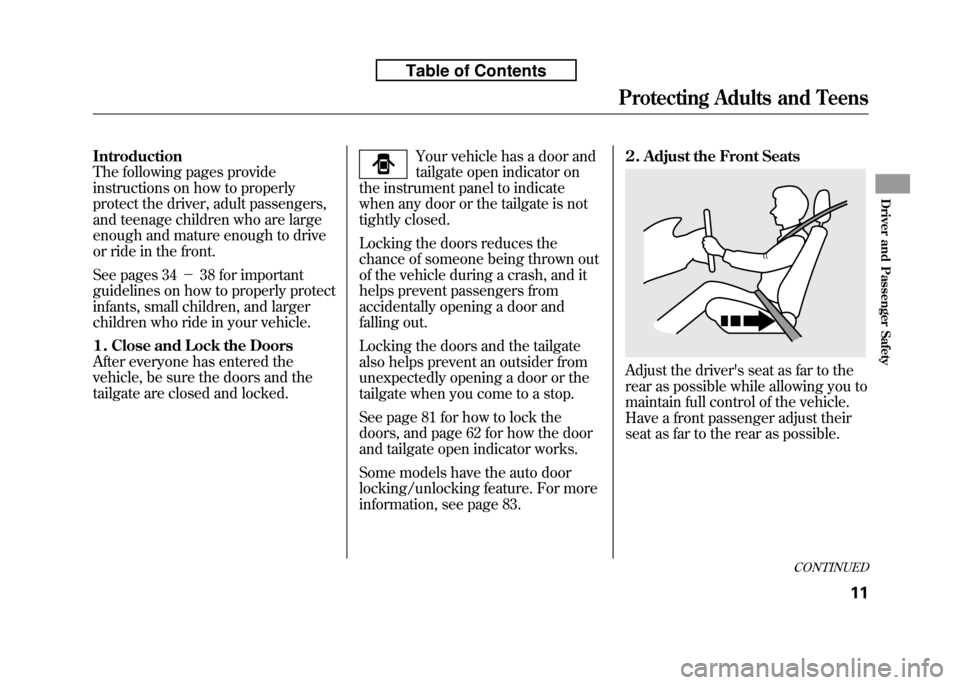
Introduction
The following pages provide
instructions on how to properly
protect the driver, adult passengers,
and teenage children who are large
enough and mature enough to drive
or ride in the front.
See pages 34-38 for important
guidelines on how to properly protect
infants, small children, and larger
children who ride in your vehicle.
1. Close and Lock the Doors
After everyone has entered the
vehicle, be sure the doors and the
tailgate are closed and locked.Your vehicle has a door and
tailgate open indicator on
the instrument panel to indicate
when any door or the tailgate is not
tightly closed.
Locking the doors reduces the
chance of someone being thrown out
of the vehicle during a crash, and it
helps prevent passengers from
accidentally opening a door and
falling out.
Locking the doors and the tailgate
also helps prevent an outsider from
unexpectedly opening a door or the
tailgate when you come to a stop.
See page 81 for how to lock the
doors, and page 62 for how the door
and tailgate open indicator works.
Some models have the auto door
locking/unlocking feature. For more
information, see page 83. 2. Adjust the Front Seats
Adjust the driver's seat as far to the
rear as possible while allowing you to
maintain full control of the vehicle.
Have a front passenger adjust their
seat as far to the rear as possible.
CONTINUED
Protecting Adults and Teens
11
Driver and Passenger Safety
Table of Contents
Page 28 of 351
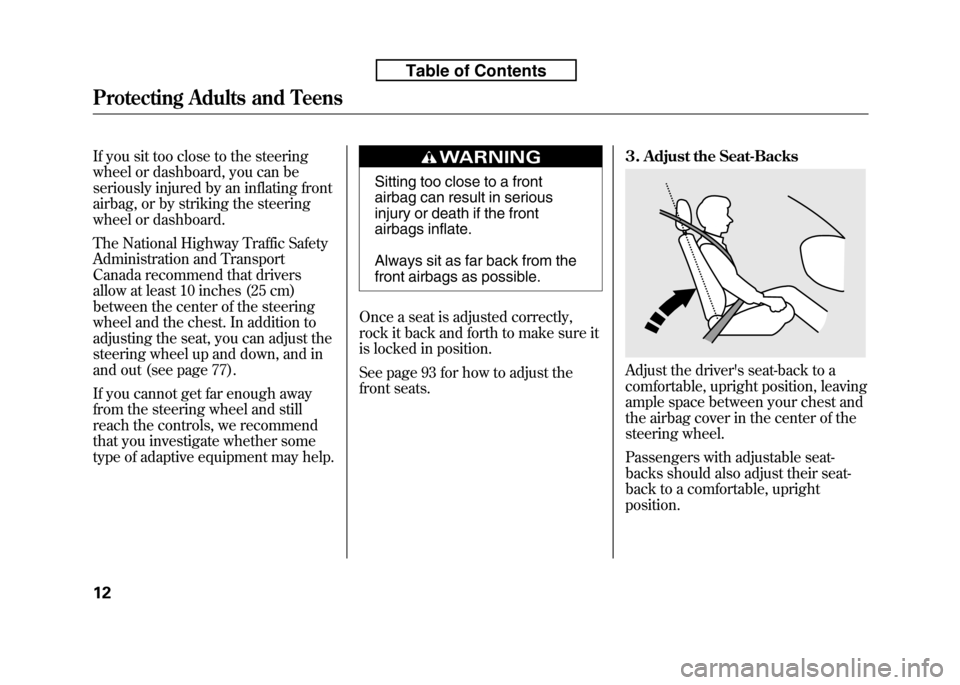
If you sit too close to the steering
wheel or dashboard, you can be
seriously injured by an inflating front
airbag, or by striking the steering
wheel or dashboard.
The National Highway Traffic Safety
Administration and Transport
Canada recommend that drivers
allow at least 10 inches (25 cm)
between the center of the steering
wheel and the chest. In addition to
adjusting the seat, you can adjust the
steering wheel up and down, and in
and out (see page 77).
If you cannot get far enough away
from the steering wheel and still
reach the controls, we recommend
that you investigate whether some
type of adaptive equipment may help.
Sitting too close to a front
airbag can result in serious
injury or death if the front
airbags inflate.
Always sit as far back from the
front airbags as possible.
Once a seat is adjusted correctly,
rock it back and forth to make sure it
is locked in position.
See page 93 for how to adjust the
front seats. 3. Adjust the Seat-Backs
Adjust the driver's seat-back to a
comfortable, upright position, leaving
ample space between your chest and
the airbag cover in the center of the
steering wheel.
Passengers with adjustable seat-
backs should also adjust their seat-
back to a comfortable, uprightposition.
Protecting Adults and Teens
12
Table of Contents
Page 31 of 351
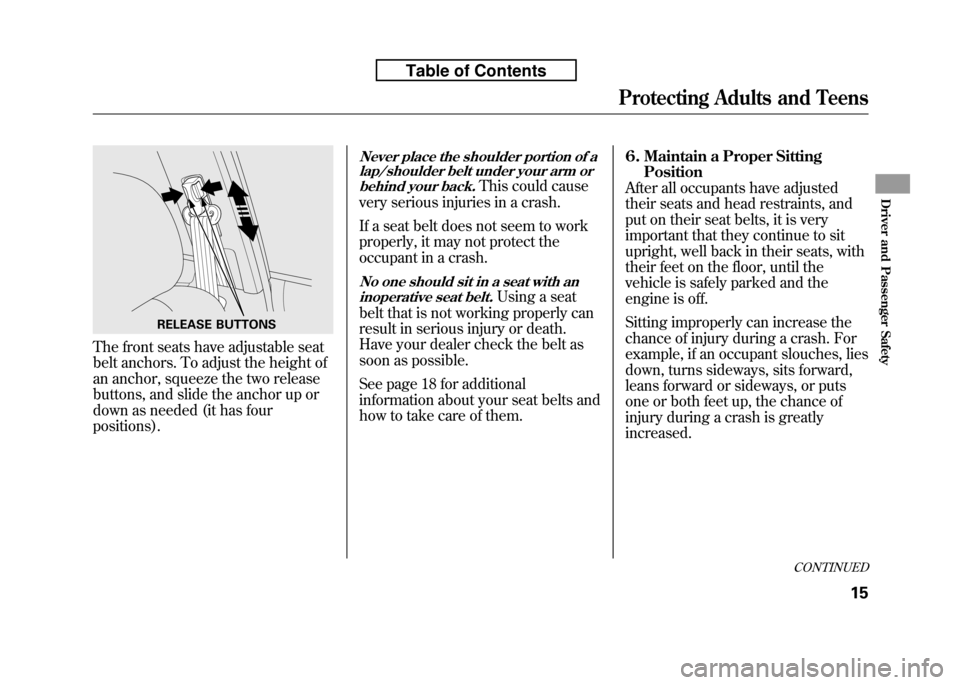
The front seats have adjustable seat
belt anchors. To adjust the height of
an anchor, squeeze the two release
buttons, and slide the anchor up or
down as needed (it has fourpositions).
Never place the shoulder portion of alap/shoulder belt under your arm or
behind your back.
This could cause
very serious injuries in a crash.
If a seat belt does not seem to work
properly, it may not protect the
occupant in a crash.
No one should sit in a seat with an inoperative seat belt.
Using a seat
belt that is not working properly can
result in serious injury or death.
Have your dealer check the belt as
soon as possible.
See page 18 for additional
information about your seat belts and
how to take care of them. 6. Maintain a Proper Sitting
Position
After all occupants have adjusted
their seats and head restraints, and
put on their seat belts, it is very
important that they continue to sit
upright, well back in their seats, with
their feet on the floor, until the
vehicle is safely parked and the
engine is off.
Sitting improperly can increase the
chance of injury during a crash. For
example, if an occupant slouches, lies
down, turns sideways, sits forward,
leans forward or sideways, or puts
one or both feet up, the chance of
injury during a crash is greatlyincreased.
RELEASE BUTTONS
CONTINUED
Protecting Adults and Teens
15
Driver and Passenger Safety
Table of Contents
Page 33 of 351

Additional Safety Precautions●
Never let passengers ride in the
cargo area or on top of a folded-
down back seat.
If they do, they
could be very seriously injured in a crash.
●
Never let passengers ride in the area in front of a folded-up rearseat or on top of a folded-down rear
seat.
If they do, they could be very
seriously injured in a crash.
●
Passengers should not stand up or change seats while the vehicle is
moving.
A passenger who is not
wearing a seat belt during a crash
or emergency stop can be thrown
against the inside of the vehicle,
against other occupants, or out of
the vehicle.
●
Two people should never use the same seat belt.
If they do, they
could be very seriously injured in acrash. ●
Do not put any accessories on seat
belts.
Devices intended to improve
occupant comfort or reposition the
shoulder part of a seat belt can
reduce the protective capability of
the belt and increase the chance of
serious injury in a crash.
●
Do not place hard or sharp objects between yourself and a front
airbag.
Carrying hard or sharp
objects on your lap, or driving with
a pipe or other sharp object in your
mouth, can result in injuries if your
front airbag inflates.
●
Keep your hands and arms away from the airbag covers.
If your
hands or arms are close to an
airbag cover, they could be injured
if the airbag inflates. ●
Do not attach or place objects on
the front airbag covers.
Objects on
the covers marked ‘‘SRS AIRBAG ’’
could interfere with the proper
operation of the airbags or be
propelled inside the vehicle and
hurt someone if the airbags inflate.
●
Do not attach hard objects on or near a door.
If a side airbag or a
side curtain airbag inflates, a cup
holder or other hard object
attached on or near the door could
be propelled inside the vehicle and
hurt someone.
●
Do not cover or replace front seat- back covers without consulting
your dealer.
Improperly replacing
or covering front seat-back covers
can prevent your side airbags from
inflating during a side impact.
Protecting Adults and Teens
17
Driver and Passenger Safety
Table of Contents
Page 43 of 351
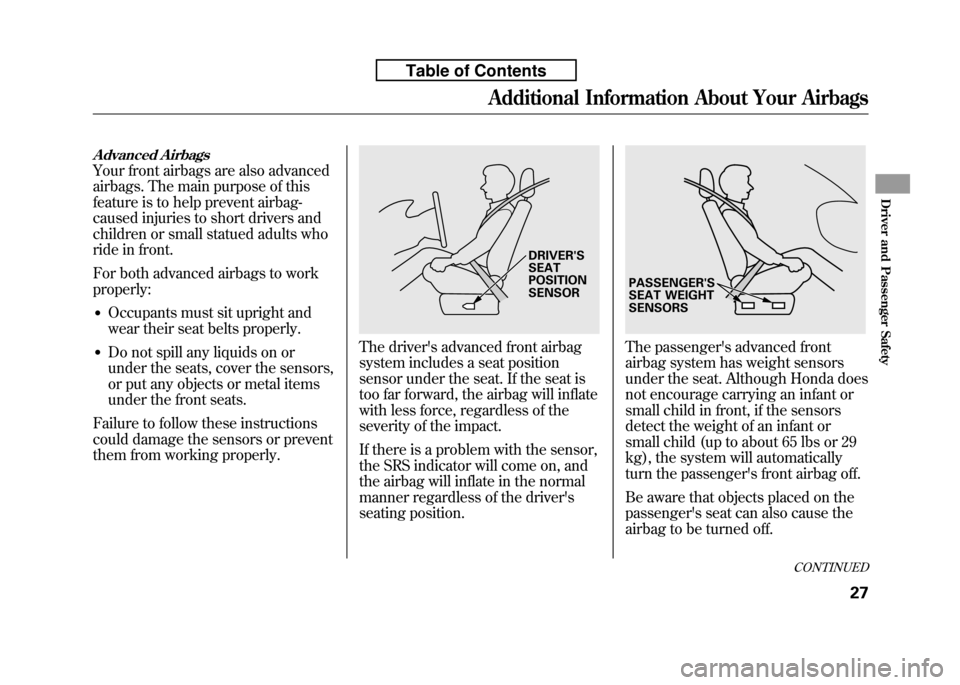
Advanced Airbags
Your front airbags are also advanced
airbags. The main purpose of this
feature is to help prevent airbag-
caused injuries to short drivers and
children or small statued adults who
ride in front.
For both advanced airbags to work properly:● Occupants must sit upright and
wear their seat belts properly.
● Do not spill any liquids on or
under the seats, cover the sensors,
or put any objects or metal items
under the front seats.
Failure to follow these instructions
could damage the sensors or prevent
them from working properly.
The driver's advanced front airbag
system includes a seat position
sensor under the seat. If the seat is
too far forward, the airbag will inflate
with less force, regardless of the
severity of the impact.
If there is a problem with the sensor,
the SRS indicator will come on, and
the airbag will inflate in the normal
manner regardless of the driver's
seating position.The passenger's advanced front
airbag system has weight sensors
under the seat. Although Honda does
not encourage carrying an infant or
small child in front, if the sensors
detect the weight of an infant or
small child (up to about 65 lbs or 29
kg), the system will automatically
turn the passenger's front airbag off.
Be aware that objects placed on the
passenger's seat can also cause the
airbag to be turned off.
DRIVER'S SEAT POSITION SENSOR
PASSENGER'S
SEAT WEIGHT
SENSORS
CONTINUED
Additional Information About Your Airbags
27
Driver and Passenger Safety
Table of Contents
Page 45 of 351

Only one airbag will deploy during a
side impact. If the impact is on the
passenger's side, the passenger's
side airbag will deploy even if there
is no passenger.
To get the best protection from the
side airbags, front seat occupants
should wear their seat belts and sit
upright and well back in their seats.Side Airbag Cutoff System
Your vehicle has a side airbag cutoff
system designed primarily to protect
a child riding in the front passenger'sseat.
Although Honda does not encourage
children to ride in front, if the
position sensors detect a child has
leaned into the side airbag's
deployment path, the airbag will shutoff.
The side airbag may also shut off if a
short adult leans sideways, or a
larger adult slouches and leans
sideways into the airbag's
deployment path.
Objects placed on the front
passenger seat can also cause the
side airbag to be shut off.If the side airbag off indicator comes
on (see page 31), have the passenger
sit upright. Once the passenger is
out of the airbag's deployment path,
the system will turn the airbag back
on, and the indicator will go out.
There will be some delay between
the moment the passenger moves
into or out of the airbag deployment
path and when the indicator comes
on or goes off.
A front seat passenger should not
use a cushion or another object as a
backrest. It may prevent the cutoff
system from working properly.
Additional Information About Your Airbags
29
Driver and Passenger Safety
Table of Contents
Page 46 of 351
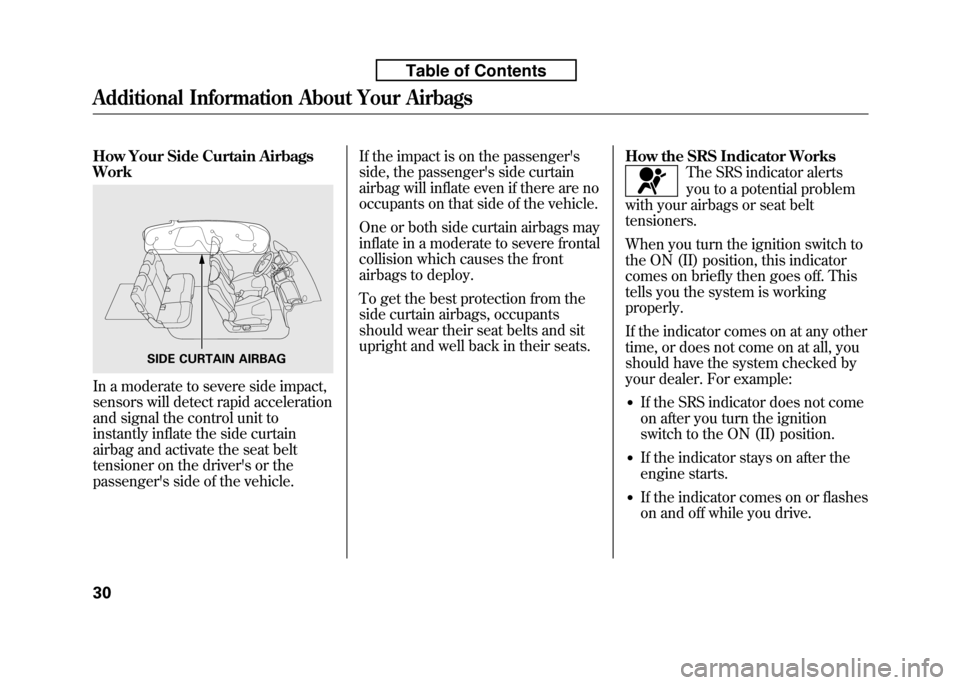
How Your Side Curtain Airbags Work
In a moderate to severe side impact,
sensors will detect rapid acceleration
and signal the control unit to
instantly inflate the side curtain
airbag and activate the seat belt
tensioner on the driver's or the
passenger's side of the vehicle.If the impact is on the passenger's
side, the passenger's side curtain
airbag will inflate even if there are no
occupants on that side of the vehicle.
One or both side curtain airbags may
inflate in a moderate to severe frontal
collision which causes the front
airbags to deploy.
To get the best protection from the
side curtain airbags, occupants
should wear their seat belts and sit
upright and well back in their seats.
How the SRS Indicator Works
The SRS indicator alerts
you to a potential problem
with your airbags or seat belt tensioners.
When you turn the ignition switch to
the ON (II) position, this indicator
comes on briefly then goes off. This
tells you the system is workingproperly.
If the indicator comes on at any other
time, or does not come on at all, you
should have the system checked by
your dealer. For example:
● If the SRS indicator does not come
on after you turn the ignition
switch to the ON (II) position.
● If the indicator stays on after the
engine starts.
● If the indicator comes on or flashes
on and off while you drive.
SIDE CURTAIN AIRBAG
Additional Information About Your Airbags
30
Table of Contents
Page 51 of 351

All Children Should Sit in a Back Seat
According to accident statistics,
children of all ages and sizes are
safer when they are restrained in a
back seat.
The National Highway Traffic Safety
Administration and Transport
Canada recommend that all children
aged 12 and under be properly
restrained in a back seat. Some
states have laws restricting where
children may ride.
Children who ride in back are less
likely to be injured by striking
interior vehicle parts during a
collision or hard braking. Also,
children cannot be injured by an
inflating front airbag when they ride
in the back.The Passenger's Front Airbag Can
Pose Serious Risks
Front airbags have been designed to
help protect adults in a moderate to
severe frontal collision. To do this,
the passenger's front airbag is quite
large, and it can inflate with enough
force to cause very serious injuries.
Even though your vehicle has an
advanced front airbag system that
automatically turns the passenger's
front airbag off under certain
circumstances (see page 31), please
follow these guidelines:
Infants
Never put a rear-facing child seat inthe front seat of a vehicle equipped
with a passenger's front airbag.
If the
airbag inflates, it can hit the back of
the child seat with enough force to
kill or very seriously injure an infant.
Small Children
Placing a forward-facing child seat inthe front seat of a vehicle equippedwith a passenger's front airbag can be
hazardous.
If the vehicle seat is too
far forward, or the child's head is
thrown forward during a collision, an
inflating front airbag can strike the
child with enough force to kill or
very seriously injure a small child.
Larger Children
Children who have outgrown childseats are also at risk of being injuredor killed by an inflating passenger's
front airbag.
Whenever possible,
larger children should sit in the back
seat, on a booster seat if needed, and
be properly restrained with a seat
belt (see page 49 for important
information about protecting largerchildren).
CONTINUED
Protecting Children -General Guidelines
35
Driver and Passenger Safety
Table of Contents